Sri Lanka crowd breaks Rajapaksa grip on power
By Anbarasan Ethirajan
BBC News, Colombo
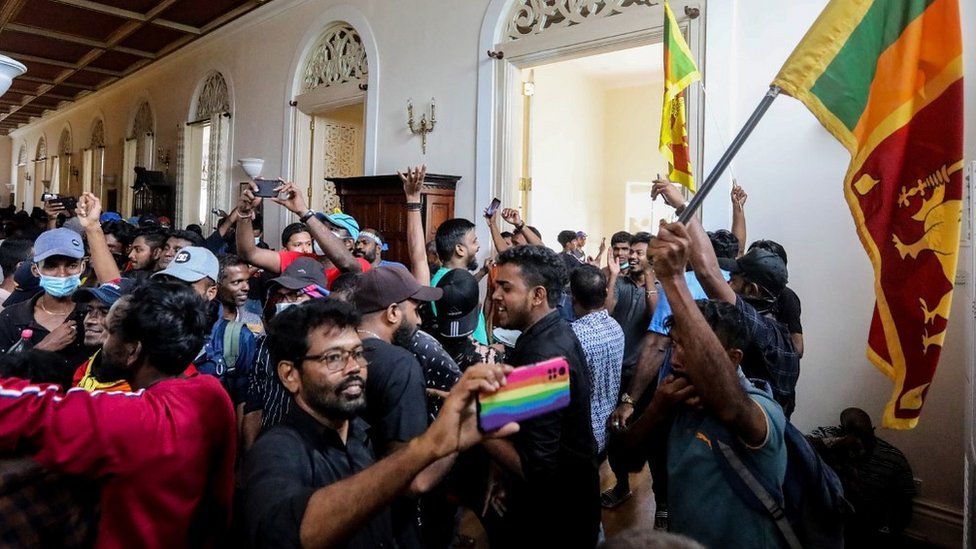 EPA
EPAThese are extraordinary times for Sri Lanka - after a day of fury and violence, the country's two senior leaders have agreed to step down.
The news triggered jubilation at the main protest site in Colombo. Firecrackers were set off in many parts of the city.
I am at the Galle Face protest site - many protesters have started returning home, thousands are still present. Some have been singing and playing musical instruments, celebrating.
What a turnaround of events. A few days ago a photo of President Gotabaya Rajapaksa and Prime Minister Ranil Wickremesinghe smiling in parliament was widely shared on social media.
Many vented their anger, saying the two men appeared to be happy while millions were struggling to eat three meals a day. But a week is a long time in politics.
President Rajapaksa's resignation has been the main demand of the protesters during months of unrest, as inflation surges and the authorities struggle to import food, fuel and medicine.
Sri Lanka is facing a crippling foreign currency shortage and has asked the International Monetary Fund for an emergency loan.
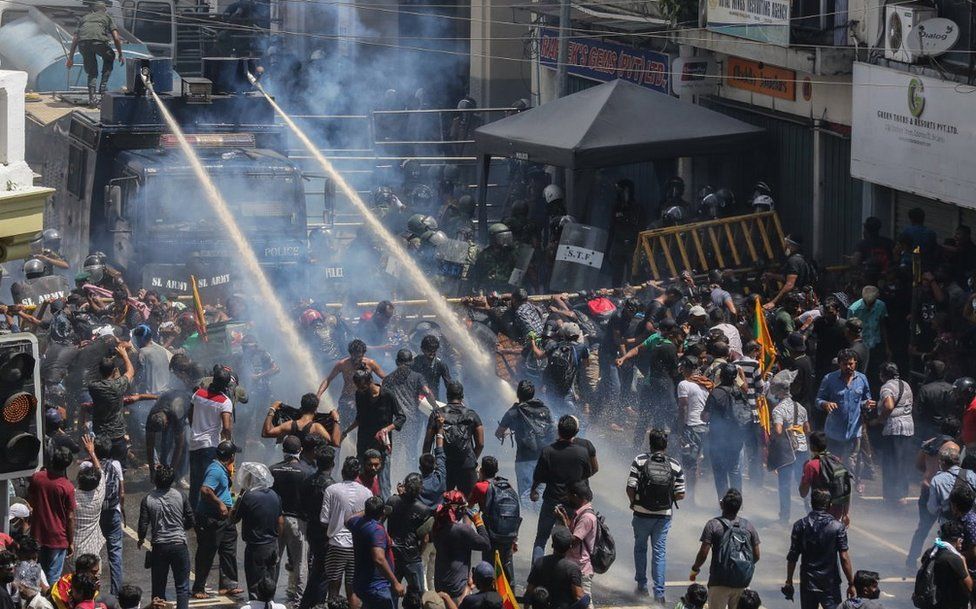 EPA
EPAI have seen President Rajapaksa at the peak of his power. He was a ruthless and much-feared man. No-one, including journalists, would want to be on the receiving end of his angry outbursts.
Many of the staunchest critics of the regime were either severely beaten or even disappeared, though the Rajapaksas - the president and his brother, former prime minister Mahinda Rajapaksa - always denied any links to the violence or disappearances.
Now President Rajapaksa fleeing his official home for safety is dramatic - unthinkable a few months ago. The man had the support of the majority Sinhala Buddhist community, after leading the military to crush the separatist Tamil Tigers in 2009.
The Rajapaksa brothers were then celebrated as war heroes. In a dramatic twist, now they face the ignominy of being overthrown by the same people who brought them to power.
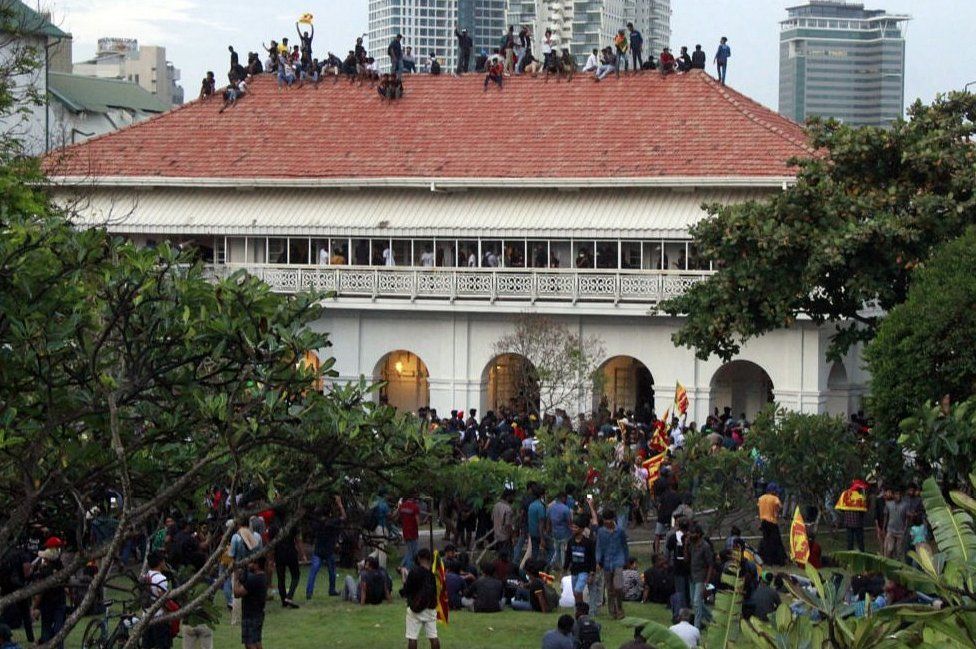 GETTY IMAGES
GETTY IMAGESSri Lanka Parliament Speaker Mahinda Yapa Abeywardena said President Gotabaya Rajapaksa will resign on July 13.
Press Trust of India
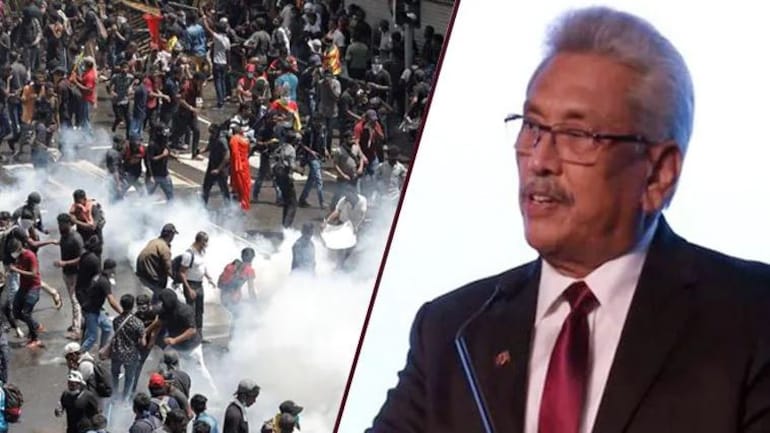
Agitating protesters on Sri Lanka streets and President Gotabaya Rajapaksa.
Sri Lanka's embattled President Gotabaya Rajapaksa would resign on Wednesday, Parliament Speaker Mahinda Yapa Abeywardena said late Saturday night, hours after thousands of protesters stormed his official residence, blaming him for an unprecedented economic crisis that has brought the country to its knees.
President Rajapaksa informed the Speaker about this decision to quit after Abeywardena wrote to him seeking his resignation following the all-party meeting of leaders held on Saturday evening.
Also read: Protesters swim in President's pool as Sri Lanka struggles to stay afloat | Watch
The party leaders had demanded the immediate resignation of President Rajapaksa and Prime Minister Ranil Wickremesinghe to make way for Abeywardena to become acting president until Parliament appointed a successor.
Wickremesinghe, 73, has already expressed his willingness to resign. But an angry mob did not spare his private home here and set it on fire.
Rajapaksa, 73, responded to the Speaker's letter, saying he would quit on July 13. Rajapaksa became Sri Lankan President in November 2020.
Earlier, Speaker Abeywardena had asked President Rajapaksa and Prime Minister Wickremesinghe to resign immediately to make way for an all-party government after the country witnessed its biggest protest yet amid an unprecedented economic crisis.
Abeywardena in his letter to Rajapaksa, whose whereabouts are still not known, informed him about the outcome of the party leaders’ meeting he had convened this evening after which Wickremesinghe offered to resign and form an all-party government.
He told Rajapaksa that party leaders wanted him and Wickremesinghe to resign immediately, Parliament to be convened in seven days to appoint an acting president, and appoint an interim all-party government under a new Prime Minister commanding majority in Parliament. It was also decided to call for elections within a short period of time and install a new government.
Rajapaksa appears to have gone underground in the face of massive public anger over an unprecedented economic crisis since the country became independent in 1948.
Earlier in the day, thousands of protesters stormed the official residence of President Rajapaksa. It is believed that President Rajapaksa left the house before the massive crowd arrived.
At least 45 people, including seven security personnel, were injured in clashes between security forces and the protesters some of them holding Sri Lankan flags and helmets - who had gathered in large numbers in the Fort area, demanding President Rajapaksa's resignation.
Sri Lanka, a country of 22 million people, is under the grip of an unprecedented economic turmoil, the worst in seven decades, crippled by an acute shortage of foreign exchange that has left it struggling to pay for essential imports of fuel, and other essentials.
The country, with an acute foreign currency crisis that resulted in foreign debt default, had announced in April that it is suspending nearly USD 7 billion foreign debt repayment due for this year out of about USD 25 billion due through 2026.
Sri Lanka's total foreign debt stands at USD 51 billion
Saturday 9 July 2022

Sri Lankan protesters forced their way into their president’s official residence on Saturday, demanding his resignation amid an economic crisis.
It was not clear if President Gotabaya Rajapaksa was inside the residence in Colombo but mobile phone footage showed crowds inside the well-fortified house and on the grounds outside.
A government spokesman, Mohana Samaranayake, said he had no information about whether Mr Rajapaksa had left the residence.
Police had earlier fired tear gas at protesters who surrounded the premises as they moved toward the main gates.
The protesters eventually broke the barricades and entered the house.
Protesters blame Rajapaksa for the economic woes and have occupied the entrance to his office for three month
Thousands have been carrying Sri Lankan flags earlier, riding on the relatively few vehicles on the roads due to an acute fuel shortage.
Others rode bicycles and many walked to protest sites in Colombo from the suburbs after police lifted an overnight curfew.
Sri Lanka's prime minister Ranil Wickremesinghe said last month that the country's economy has collapsed.
The government's negotiations with the International Monetary Fund have been complex because it has now entered negotiations as a bankrupt state.
In April, Sri Lanka announced it is suspending repaying foreign loans due to a foreign currency shortage.
Its total foreign debt amounts to $51 billion, of which it must repay $28 billion by the end of 2027
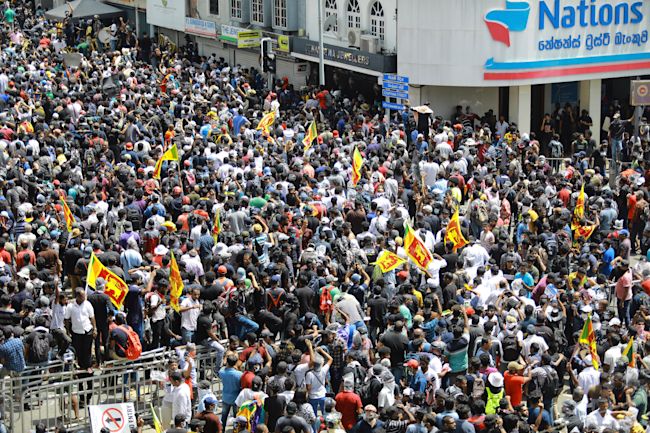
Police imposed a curfew in Colombo and several other main urban areas on Friday night but withdrew it on Saturday morning amid objections by lawyers and opposition politicians who called it illegal.
US Ambassador to Sri Lanka Julie Chung on Friday asked people to protest peacefully and called for the military and police “to grant peaceful protesters the space and security to do so.”
“Chaos & force will not fix the economy or bring the political stability that Sri Lankans need right now,” Ms Chung said in a tweet.
The economic crisis has led to a heavy shortage of essentials like fuel, cooking gas and medicines, forcing people to stand in long lines to buy the limited supplies.

SAT, 09 JUL, 2022 -
KRISHAN FRANCIS, ASSOCIATED PRESS
Sri Lankan protesters demanding the resignation of President Gotabaya Rajapaksa have forced their way into his official residence and nearby office, as thousands of people took to the streets of the capital Colombo decrying the nation’s worst economic crisis in recent memory.
It is not clear if Mr Rajapaksa was at the residence in Colombo, but footage filmed on mobile phones showed a large number of people inside the well-fortified house and on the grounds outside.
Hundreds of protesters, some carrying national flags, also entered the president’s office in a nearby building.
Protesters blame Mr Rajapaksa for the economic woes and they have occupied the entrance to his office building for the past three months calling on him to step down.

Video posted on social media showed hundreds of protesters running into the president’s residence, chanting “Gota go home”, calling the president by his nickname. Outside the building, barricades were overturned.
At the president’s office, security personnel tried to stop protesters who passed through the fences and stormed the colonial-era parliament building, which has been converted into his office.
At least 34 people including two police officers were injured in scuffles as protesters tried to enter the residence. Police fired tear gas at protesters.
Two of the injured are in a critical condition while others have sustained minor injuries, hospital officials said.
Thousands of protesters had entered Colombo from the suburbs earlier on Saturday after police lifted an overnight curfew.

Sri Lanka’s Prime Minister Ranil Wickremesinghe said last month that the country’s economy has collapsed. The government’s negotiations with the International Monetary Fund have been complex because it has now entered talks as a bankrupt state.
In April, Sri Lanka announced it is suspending repaying foreign loans due to a foreign currency shortage. Its total foreign debt amounts to 51 billion US dollars (£42.4 billion), of which it must repay 28 billion (£23.3 billion) by the end of 2027.
US Ambassador to Sri Lanka Julie Chung on Friday asked people to protest peacefully and called for the military and police “to grant peaceful protesters the space and security to do so”.
She said in a tweet: “Chaos & force will not fix the economy or bring the political stability that Sri Lankans need right now.”

The economic crisis has led to a heavy shortage of essentials like fuel, cooking gas and medicines, forcing people to stand in long queues to buy the limited supplies.
Months of protests have nearly dismantled the Rajapaksa political dynasty that has ruled Sri Lanka for most of the past two decades.
One of Mr Rajapaksa’s brothers resigned as prime minister last month, and two other brothers and a nephew quit their cabinet posts earlier, but Mr Rajapaksa has held on to power.
Mr Wickremesinghe took over as prime minister in May and protests temporarily waned in the hope he could find cash for the country’s urgent needs, but people now want him to resign saying he has failed to fulfil his promises.
The curfew was lifted after a large number of anti-government protesters hit the streets and even forced railway authorities to operate trains to take them to Colombo for Saturday's rally.
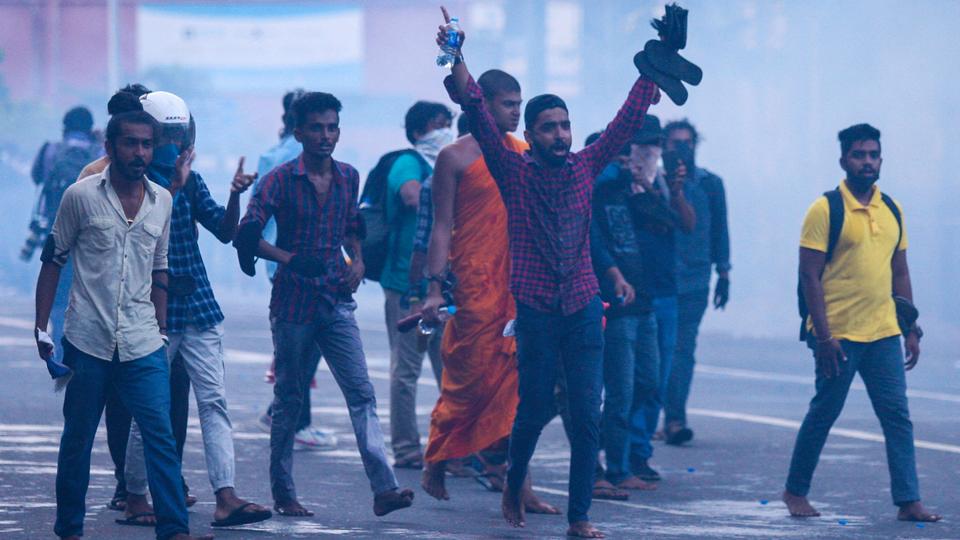
Crisis-hit Sri Lanka has lifted a curfew already defied by thousands of people overnight, ahead of a mass rally planned for later in the day demanding President Gotabaya Rajapaksa's resignation.
Huge crowds already poured into the capital Colombo on Saturday for the demonstration, the latest expression of unrest sparked by the country's unprecedented economic crisis.
Police withdrew the stay-home order issued the previous evening after opposition parties, rights activists and the bar association threatened to sue the police chief.
Thousands of anti-government protesters ignored the curfew and even forced railway authorities to operate trains to take them to Colombo for Saturday's rally, officials said.
"The curfew was not a deterrent, in fact it encouraged more people to get on the streets in defiance," a top defence official told AFP.
"Passengers had commandeered trains to reach Colombo."
Economic crisis
Sri Lanka has suffered through months of food and fuel shortages, lengthy blackouts and galloping inflation after running out of foreign currency to import vital goods.
The country has nearly exhausted already scarce supplies of petrol, but protesters backed by main opposition parties, had hired private buses to travel to the capital.
Demonstrators have camped outside Rajapaksa's seafront office to demand his resignation over the government's mismanagement of the crisis.
Thousands of soldiers armed with assault rifles were bussed into Colombo on Friday to reinforce police guarding Rajapaksa's official residence, which protesters have vowed to storm on Saturday.
Authorities have deployed nearly 20,000 troops and police officers for a security operation to protect the president.
On Friday, three judges refused police requests to outlaw Saturday's protests.
The United Nations urged both authorities and protesters to ensure that Saturday's demonstrations were peaceful.
"We urge Sri Lankan authorities to show restraint in the policing of assemblies and ensure every necessary effort to prevent violence," the Office of the UN High Commissioner for Human Rights said.
Nine people were killed and hundreds wounded when clashes erupted across the country after Rajapaksa loyalists attacked peaceful protesters outside the president's office in May.
Sri Lanka has defaulted on its $51 billion external debt and has been in bailout talks with the International Monetary Fund.
'We will not give up until this president and prime minister go home,' protesters have said.

Police use tear gas and water cannon to disperse demonstrators near President's residence during a protest demanding the resignation of President Gotabaya Rajapaksa, amid the country's economic crisis, in Colombo, Sri Lanka, July 8, 2022. Photo: Reuters/Dinuka Liyanawatte
The Wire Staff
New Delhi: With Sri Lankan Police lifting the curfew that was imposed in seven divisions in the country’s Western Province, including Colombo, large numbers have been heading to the commercial capital for the anti-government protests planned today, July 9 and tomorrow.
A massive rally to Colombo from around the country was planned by religious leaders, political parties, medical practitioners, teachers, civil rights activists, farmers, and fishermen, demanding the resignation of President Gotabaya Rajapaksa and Prime Minister Ranil Wickremesinghe.
Police in Colombo on Friday fired tear gas and used a water cannon on student protesters. The students staged a sit-in overnight, with other protesters including healthcare workers, clergy, trade unions and opposition supporters joining them on Saturday, organisers told reporters.
Sri Lankan media has reported that as the second Test with Australia is underway in the Galle International Cricket Stadium, protestors have made their way to the Galle Fort, overlooking the grounds, breaking police barricades.
Removal of curfew after pressure from top bodies
Cops removed curfew after coming under pressure from the top lawyers’ association – the Bar Association of Sri Lanka –, human rights groups and political parties.
The curfew was imposed in seven police divisions in the Western Province, which included Negombo, Kelaniya, Nugegoda, Mount Lavinia, Colombo North, Colombo South and Colombo Central with effect from 9 pm of Friday night until further notice, Inspector General of Police (IGP) C. D. Wickramaratne had announced on Friday.
The Bar Association of Sri Lanka and The Human Rights Commission of Sri Lanka protested the police curfew, terming it illegal and a violation of fundamental rights.
The island nation has been crippled by a shortage of foreign exchange that has left it struggling to pay for essential imports of fuel, food and medicine. Its 22 million people have been bearing the brunt of record inflation, currency depreciation and rolling power cuts for months.
Many blame President Gotabaya Rajapaksa for the swift slide in living conditions, the worst since independence in 1948, which has sparked widespread protests that have sometimes turned violent.

Police use tear gas and water cannon to disperse demonstrators near President’s residence during a protest demanding the resignation of President Gotabaya Rajapaksa, amid the country’s economic crisis, in Colombo, Sri Lanka, July 8, 2022. Photo: Reuters/Dinuka Liyanawatte
“People are dying in fuel queues and can barely manage three meals a day. This is what the president and his government have done to this country,” said Wasantha Mudalige, a member of the Inter University Students’ Federation that organised a march to the president’s house on Friday.
“We will not give up until this president and prime minister go home,” Mudalige said, referring to Ranil Wickremesinghe who was appointed as prime minister in May to replace Rajapaksa’s elder brother after he stepped down.
In a statement, Rajapaksa said the public were being misled and said essential supplies were scheduled to be delivered soon.
“At a time when successful solutions have been achieved to the existing problematic situation, the programme of the opposition political groups to mislead the people is very sad and unpleasant,” the statement said. “This will lead to set the country back once again.”
A spokesperson for the UN High Commissioner for Human Rights said there were concerns over Saturday’s protest turning violent.
“With security forces we have seen the use of lethal weapons in protests. This is why we are putting out this preventive call because we are very concerned about what might happen tomorrow,” Ravina Shamdasani told reporters.
U.S. Ambassador to Sri Lanka Julie Chung called for the military and police to allow peaceful protests.
Political instability could potentially undermine Sri Lanka’s ongoing talks with the International Monetary Fund (IMF) for a potential $3 billion bailout.
The country hopes to submit a debt restructuring plan to the global lender by August and raise additional funding via a donor conference after reaching a staff level agreement.
(With Reuters inputs)
No comments:
Post a Comment